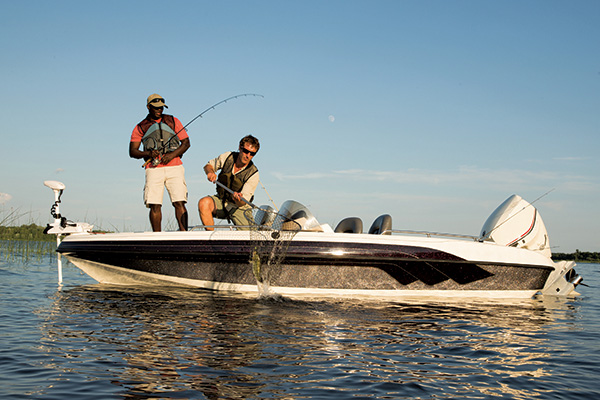Fishing for a pandemic panacea

By David Gee
More than 49 million Americans find their way to freshwater, saltwater and fly fishing ever year, but fishing’s popularity has surged since the COVID-19 crisis gripped the country.
“Fishing is obviously something you can easily and safely do while social distancing,” says Stephanie Vatalaro, senior vice president of marketing and communications for the Recreational Boating & Fishing Foundation. “The other thing we are emphasizing, along with the National Marine Manufacturers Association, is the restorative power of fishing and boating. Spending quality time with your quarantine group, getting outside and unplugging from the world is a really attractive proposition right now. And we are benefiting from that.”
Vatalaro told Boating Industry that some states have seen a rise of 40% or more in the numbers of fishing licenses sold.
And the RBFF has seen a nearly 400% increase in organic web traffic (traffic they didn’t pay for) since the covid crisis hit.
Vatalaro says people are hungry for information about how to get started fishing and how – and where – to get a fishing license.
“It’s great we are getting new people to try fishing, but we also want to hold on to them after this is over,” she continued. “Our research shows it takes about three times to get people truly hooked on fishing, so we are putting lots of effort towards retention.”
Mixed messaging
Every spring the Recreational Boating and Fishing Foundation puts lots of effort towards new marketing campaigns aimed at getting people to wet a line.
But they realized this year, right in the heart of the initial coronavirus wave, the messaging was all wrong.

So the two Franks who head up RBFF and the NMMA began talking about how they could partner. And the organizations quickly created an industry-wide campaign featuring a public service announcement (PSA), online advertising, social media, and public relations. They’re all targeted to local areas to ensure a focus on responsible and safe boating and fishing.
“Consumer insights show people are longing for a return to the outdoors, and fishing and boating can be a safe and fun way to social distance and relieve stress,” said RBFF president and CEO Frank Peterson. “We want to help people find their way back out to the water while helping our industry rebuild coming out of this global pandemic.”
“Throughout history, boating and fishing have provided an escape – a way to chart your own course and create your own adventure – that can only be experienced on the water,” notes NMMA president Frank Hugelmeyer. “Being able to trailer your own boat to your local waterway and be in charge of who you encounter, provides a bit of control in what is one of the most uncertain and uneasy environments of our time. By coming together as an industry, we have a shot at telling this story like never before and demonstrating how boating and fishing can be the remedy we’re all seeking.”

In what is being called unprecedented coordination, Take Me Fishing and Discover Boating, in addition to engaging other industry groups including the American Sportfishing Association, the Marine Retailers Association of America, BoatUS, marine trade associations and others, are telling the industry’s story around the country. By pooling resources, the groups will gain access to marketing channels in new ways and help the industry come out of the pandemic.
“Boating and fishing offer a way to cope with our new reality – being outdoors, spending time with those closest to you, and doing so safely,” added Peterson. “With so many different stakeholders working as a team on this campaign, it gives us a tremendous path to rebuild our industry, together.
Reversing the decline
The marketing muscle and positive metrics come as good news for the fish and aquatic resource management community, who became justifiably concerned with the decline in fishing participation in the 1990s.
Anglers are an important constituency for conservation and aquatic resources as well as the primary source of funding for fisheries conservation and management.
Substantial funding for aquatic resource management is derived from fishing license sales; an excise tax on fishing-related equipment such as rods, reels, and related tackle; and a tax on motorboat and small engine fuel.
In fact, the RBFF was born in 1998 out of this concern over declining fishing participation. Since their inception, RBFF has sponsored an array of studies over the years concerning Americans’ attitudes toward fishing in general; trends in fishing participation among various demographic groups; angler churn; motivations for and barriers to fishing participation; recruitment, retention, and reactivation strategies and tactics; and more.
One of the organization’s key findings over the years is that nearly 78% of current adult participants were introduced to fishing during childhood. After the age of 12, it is much less likely for a person to try fishing.
So it is especially good to note that youth participation among children, ages 6 to 12, has been growing over the past three or four years.

RBFF’s Vatalaro says in fact their main target audience is young families.
“We are really good at getting kids out fishing,” she said. “But the key is to get their parents out more as well.”
Hispanic participation in fishing also is continuing its rapid growth.
And female participation in fishing recently reached an all-time high.
“The future of fishing certainly looks really good right now,” stated Vatalaro in closing. “All the metrics and the indicators are great. But we’re also really hoping people will stick with it on the other side of the pandemic.”




